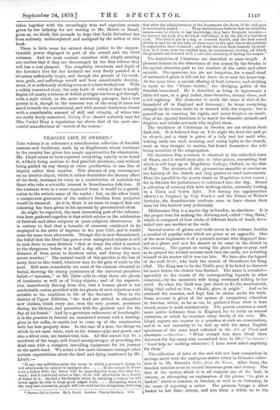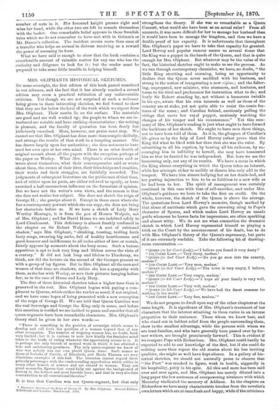PEASANT LIFE IN SWEDEN.* Tins volume is in substance a
miscellaneous collection of Swedish customs and traditions, made by an Englishman whose residence in the country has given him ample opportunities for observation. Mr. Lloyd seems to have reported everything exactly as he found it, without being anxious to find parallels elsewhere, and without being guided by any theory or other predilection to one line of
inquiry rather than another. This absence of any convergence on an ulterior object, whilst it rather diminishes the literary effect of the book, increases its value as a contribution of materials for those who take a scientific interest in Scandinavian folk-lore. If the contents were in a more organized form it would be a gratifi- cation to the artistic sense of the reader ; but, on the other hand, a conspicuous guarantee of the author's freedom from prejudice would be removed. As it is, there is no room to suspect that any colouring has been given to his accounts by preconceived ideas.
As might be expected, the most interesting part of the informa- tion here gathered together is that which relates to the celebration of festivals and other religious or quasi-religious observances. It is curious to find that a formula of exorcism continued to be employed in the order of baptism in the year 1529, and it would seem for some time afterwards. Though this is now discontinued, the belief that the Devil has power over unbaptized infants is still in such force in some districts "that at times the child is carried to the clergyman before it is half a day old, and this often to a distance of from seven to fourteen miles, and during the most severe weather." The natural result of this practice is the loss of many lives to this world, whatever may be the gain of souls to the next. Still more remarkable are some of the customs observed in burial, showing the strong persistence of the universal primitive belief—" animism," as Mr. Tylor calls it—that there are ghosts of inanimate as well as of living objects ; and of the supersti- tion immediately flowing from this, that a human ghost is not comfortable unless provided with the ghosts of such objects as were suitable to the condition in life of the deceased. Thus in the district of Upper Elfdalen, "the dead are attired in altogether new clothes, which every one, even the very poorest, purchases during his lifetime, and preserves with the greatest care for the day of his burial." And by a grotesque refinement of forethought, it is the practice to furnish an unmarried woman with a looking- glass in her coffin, to enable her to come up at the resurrection with her hair properly done. In the case of a man, the things on which he set most value, such as his tobacco-pipe and pouch, and also a silver coin, are buried with him. All this cannot but be a residuum of the usage, still found among savages, of providing the dead man with a complete travelling equipment for his journey to the spirit-land. We select a few more instances amongst other curious superstitions about the dead and dying mentioned by Mr.
Lloyd :—
"If any one unbidden enter the room in which a person is dying, he
will afterwards be subject to epileptic fits If the corpse be borne over a fallow field, the latter will be unproductive from that time for- ward ; and if conveyed across a lake, there will afterwards be a dearth of fishes in it. Should a blacksmith assist in carrying a corpse, be will never again be able to forge good edged tools. . . . Excepting when in the very last extremity, people will not send for the clergyman, believing
• Peasant Life in Sweden. By L. Lloyd. London : Tinsley Brothers. 1870. that after the administration of the Sacrament the doom of the sick man is irrevocably sealed They furthermore believe that an infallible means—one to which, to my knowledge, they have frequent recourse— to recover the body of a drowned individual, is by the aid of a barndoor cock. The bird is put in a bag or covered basket, and the boat rowed slowly to and fro in the lake or river near to the spot where the accident is supposed to have occurred ; and when the cock finds himself, by intui- tion, as it were, over the sunken man, he commences crowing, on which the grapnels are lowered with a tolerable certainty of finding the corpse."
The festivities of Christmas are described at some length. A pleasant feature in the observance of this season by the Swedes is
the special attention paid to the comfort of the cattle and other animals. The sparrows, too, are not forgotten, for a small sheaf of unthrashed grain is left out for them on or near the house-top. At the same time, a special offering of food, tobacco, and clothing is made to the "'fomte Gubbe," the drudging goblin of the Swedish homestead. He is described as being in appearance a little old man, in a grey jacket, knee-breeches, clumsy shoes, and a red nightcap. His character is much the same as that of the
household elf in England and Germany ; he keeps everything straight in the house while he is treated with due respect ; but is punctilious in exacting his rights, and never forgives an insult.
One of his especial functions is to watch the domestic animals and frighten and rebuke servants who neglect them.
The traditions of Christmas in Sweden are not without their dark side. It is believed that on Yule night the dead rise and go to church, and a story is given of a lady and her maid who, waking early one such morning, and seeing lights in the church, went as they thought to matins, but found themselves the sole living members of the congregation.
On Ascension Day a custom is observed in the cathedral town of Skara, and it would seem also in other places, resembling that which is still kept up at Magdalene College, Oxford, on the first of May. The students of the gymnasium assemble at sunrise on the balcony of the church and sing psalms to wind instruments. Here the parallel to the yearly chant on Magdalene tower ceases ; for in Sweden the performance is continued into the day. Hence a collection of country folk with walking-sticks, naturally leading to a Town and Gown fight. Not having the opportunities afforded in England by Guy Fawkes and the Prince of Wales's birthday, the Scandinavian students seem to have chosen their time for this festival very judiciously.
Midsummer Day is a mystic day in Sweden, as elsewhere. It is the proper time for making the divining-rod, called "Slag Huta," which is composed of four sticks of different kinds of wood, dove- tailed into one another at the ends.
Several stories of ghosts and trolls occur in the volume, besides a number of popular tales which are given as an appendix. One of the most impressive is of a parson's servant who disguised him- self as a ghost, and met his master as he came to the church in. the evening. The parson on seeing the ghost began to pray, and as he prayed the wicked servant sank into the earth, not revealing himself to his master till it was too late. We have also the legend of the troll &Wile, who built the church of Drontheim for King Olaf. The King was to be the Troll's prey if he failed to discover
his name before the church was finished. The name is revealed— agreeably to the course of the corresponding legends in other countries—by the monster's wife being overheard talking to her child. So when the Troll was just about to fix the weathercock, King Olaf called to him, " Skalle, place it aright." And so he enslaved the monster, and kept him in chains under his table. Some account is given of the system of compulsory education in Sweden, which, as far as can be gathered from what is here stated, seems to work satisfactorily. The parson exercises a much more active influence than in England, for lie holds an annual visitation, at which he examines every family of his cure. Mr. Lloyd reports one answer to a question at such an examination,
and it is not unworthy to be laid up with the many English specimens of the same kind collected in the An of Pluck and elsewhere :—Qaestion : " What reward dot thou think thou deservest for thy many sins committed here in life ? "—Answer:
"Lord help us ! nothing whatever ; I have never asked anything for them."
The collection of tales at the end will not bear comparison in average merit with the analogous stories either in Grimm's collec-
tion or in Mr. Dasent's Riles from the Norse. After these, the Swedish versions seem in several instances gross and clumsy. The first of the stories, which is in all respects one of the best, is curious, as attempting an explanation of the phrase "to give a basket," which is common in Sweden, as well as in Germany, in the sense of rejecting a suitor. The princess brings a silver
basket to her three suitors, and sets them a riddle as to the
slumber of nuts in it. Her favoured knight guesses right and wins her hand, while the other two are left to console themselves with the basket. One remarkable belief appears in these Swedish tales which we do not remember to have met with in Grimm's or Mr. Dasent's collection. The incident occurs more than once of a traveller who helps an animal in distress receiving as a reward -the power of assuming its form.
What we have said is enough to show that the book contains a -considerable amount of valuable matter for any one who has the .curiosity and diligence to look for it ; but the reader must be prepared to take some little trouble in helping himself.































 Previous page
Previous page